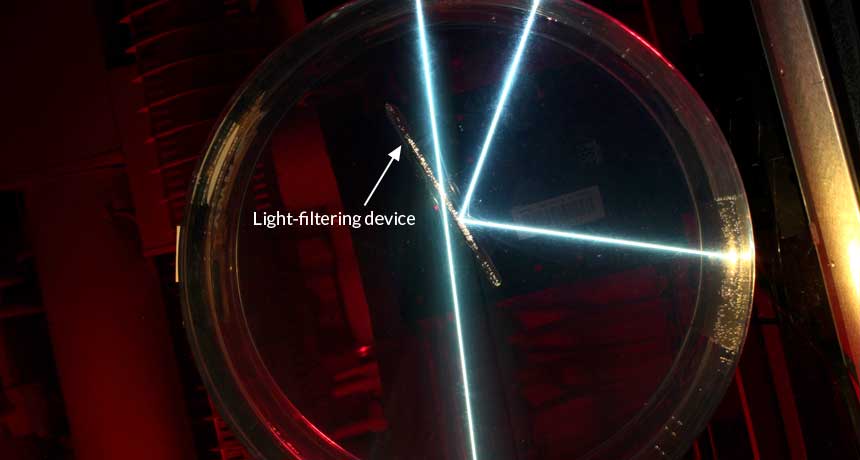Filter lets in only the right light
This new device lets light from one direction pass through — and blocks all of the rest

A new filter lets light pass through — but only if it's coming from just the right angle. Here, a light ray coming in at the 1-o’clock position reflects off the filter. But the other beam streaks straight on through.
WEISHUN XU AND YUHAO
Share this:
- Share via email (Opens in new window) Email
- Click to share on Facebook (Opens in new window) Facebook
- Click to share on X (Opens in new window) X
- Click to share on Pinterest (Opens in new window) Pinterest
- Click to share on Reddit (Opens in new window) Reddit
- Share to Google Classroom (Opens in new window) Google Classroom
- Click to print (Opens in new window) Print
Scientists have just created a new kind of light filter that’s exceptionally picky. Built from a stack of transparent materials, it only lets in light that comes from a particular direction. Everything else will just reflect off of it.
Such a device could improve cameras by reducing glare from the sun. The new filter could increase the sensitivity of telescopes by blocking light from bright stars that might otherwise wash out dimmer objects. It might boost the performance of solar cells, which convert light into electricity. It might even prevent busybodies from sneaking a sideways peek at what’s on your computer screen.
People have filtered light for thousands of years. Stained glass, for example, permits light of only one color to pass through. Each lens in a pair of 3D glasses only allows certain light to pass through. (Each eye receives a different image. Only when the brain combines those two separate images into one does an image appear to jump off the screen.) The new filter is the first to select for light from one particular direction.
Yichen Shen of the Massachusetts Institute of Technology, in Cambridge, worked on the new device. As a physicist, he and his fellow scientists understand a lot about how light behaves. They knew that when it passes through one material and enters another, it may change direction. (You can see this change for yourself in how a drinking straw in a glass of water appears to bend where the water meets the air.) Light also may get reflected. But if light strikes the second material at just the right angle, it continues unchanged. Scientists refer to that as the Brewster angle.
Shen and his colleagues built their new filter using alternating layers of glass and tantalum oxide. That second material is sometimes used to make lenses. The scientists knew that the Brewster angle for light traveling through the one material and into the second was 55 degrees from vertical.
The experts wanted to make sure that light coming from any other angle would be completely blocked. So they stacked 84 ultra-thin layers of their two transparent materials. This made up their new filter. Now, any unwanted light should be reflected or bent as it travels from one layer to the next. With so many layers, the filter eventually would reflect all unwanted light. Only light from the desired angle should shine through. And the researchers reported achieving success March 27 in Science.
“It’s a very clever approach,” Peter Bermel told Science News. An electrical engineer at Purdue University in West Lafayette, Ind., he did not work on the new filter.
Shen and his colleagues tested their 2-by-4 centimeter (0.8-by-1.6 inch) filter by placing it between a camera and a picture of a rainbow. From just about every position in which they rotated the filter, it worked like a mirror. At each of these angles, the rainbow remained blocked from view. But when the scientists placed the filter at an angle to the camera of 55 degrees (from vertical), the device became transparent. At last the rainbow showed through.
Shen and his colleagues report that every color passed through the filter without problems. The same approach should work by stacking nearly any pair of transparent materials, Shen told Science News.
Power Words
angle The space (usually measured in degrees) between two intersecting lines or surfaces at or close to the point where they meet.
Brewster angle The angle — relative to a plane running vertical (up and down) — at which light entering a new material does not bend.
engineering The field of research that uses math and science to solve practical problems.
filter A screen, plate or layer of a substance that absorbs light or other radiation or selectively prevents the transmission of some of its components.
lens (in physics) A transparent material that can either focus or spread out parallel rays of light as they pass through it.
physicist A scientist who studies the nature and properties of matter and energy.
transparent Allowing light to pass through so that objects behind can be distinctly seen.
vertical A direction referring to up and down. The opposite of horizontal, which would run parallel to the ground.







